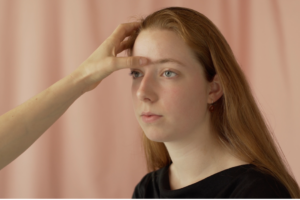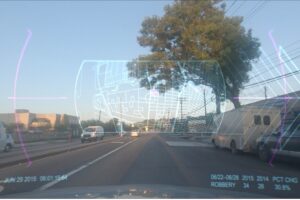In the College of Fine Arts’ Visual Art Center, a bold exhibition presented art inspired by the human urge to categorize the world around us and its impact on the development of AI technologies.
A Well-trained Eye features contemporary works by 13 artists from the Americas and Europe that were all created between 2009 and 2023.
Broadly speaking, each artwork reflects upon the idea of categorization, categorical thinking and classification, and specifically how that has been a cornerstone for developing AI as a way of teaching machines to see the world.
We train machines to understand differences by showing them a variety of patterns, shapes, people, etc. so that they can distinguish between A and B. And then when presented with one or the other they can determine one is definitely A or one is definitely B.
This is problematic for two reasons. Life, as we all know, isn’t binary; it’s a multilayered contextual experience, unique for each and every individual. Secondly, and perhaps more importantly, this isn’t an inherent way for machines to operate, calculate and delineate either. So why would humans be inclined to impose an oversimplified understanding of the world upon technologies that grow ever more ubiquitous?
In fact, it is perhaps more human than we like to admit. “We have a tendency to organize and compartmentalize so much of our experiences as a means of tricking ourselves into believing we understand, and in turn, control, the world around us,” said María Emilia Fernández, curator of A Well-trained Eye.
We organize things in our lives by shape, by color, by size, by taste and more. And we frequently do the same with people.
“We organize our relationships, we organize our feelings according to categories. The minute that we label something it’s helping us navigate our reality,” Fernández said.
AI: Then and Now
The exhibition is a fascinating and eclectic mix of pieces that span almost two decades. (That’s right. We have been living with AI in various forms for longer than we think.)
Some of the exhibition’s pieces focus on the more humorous elements of AI in the modern age – such as a video inspired by online dating apps where one’s decision to swipe left or right on a smartphone (that would otherwise result in nothing more than a digital rejection) instead shows faces being physically inflicted by an anonymous hand as they appear on screen.


Others depict the dangers of predictive policing systems registering “suspicious” behavior in an urban setting. Someone innocently running, for example, from point A to point B could sound alarm bells in an AI-driven policing system even if said person is simply exercising rather than running from the scene of a crime.
Others still offer simple insights into how different individual perceptions of colors can vary significantly using a series of postcards with a circular hole in them while also showing a broad range of blues.
In Macarena Ruiz-Tagle’s Cyanometer Postcard, one is charged with determining the shade of blue they believe the sky most closely resembles. Another postcard offers the entire gamut of shades of red to orange to yellow – a color scheme that is particularly relevant in Texas with its breathtaking sunsets.

AI, the Arts & Impact
Artists routinely face the challenge of defining the societal impact of their research.
“Artists don’t always offer solutions. Rather they challenge us to see how the world around us is changing based on the directions we take,” Fernández said. “Quantifying the value of that isn’t easy because we don’t think about things that way. We don’t have a language to describe impact.”
A Well-trained Eye might be seen as a collection of words from various dialects, rather than a language, describing our relationship with AI.
A Well-trained Eye and Good Systems
The exhibition has been consciously curated so as to neither celebrate nor condemn AI technology. The approach mirrors UT Austin’s Good Systems — one of three interdisciplinary Grand Challenges focused on understanding what opportunities and challenges the new technology will bring and working to mitigate the harms or unintended consequences it could cause while leveraging the benefits AI provides for the good of society.
“The artists did a wonderful job translating an ostensibly invisible concept like AI — that lives exclusively in the digital world — into something we can see, hear and feel in the physical world,” said Junfeng Jiao, director of the UT Ethical AI NRT program, associate professor in the School of Architecture, and an executive team member of the Good Systems research collaboration. “In doing so, it helps a general audience better understand the importance of AI because, like it or not, it’s already a part of everyday life.”
Longhorns have been at the forefront of AI technologies for over five decades, and UT has been home to some of the biggest pioneers in the field. With dozens of labs, research centers and initiatives, the University has become known as a global leader in AI — from our sought-after thought leaders; to our collaborative, cross-disciplinary projects and breakthroughs in research; to our new degree and learning opportunities; to our understanding of the ethical and societal impacts; to how we’re approaching AI in the classroom.
Learn more about UT’s “Year of AI” initiative and other AI news and campus events at yearofai.utexas.edu.
Student Perspectives on A Well-trained Eye
Students in UT’s NRT Ethical AI program give us their take on just how well-trained the artists’ eyes are.

“The exhibit offers a really broad look at the way AI is impacting our lives. It’s critical that we think ethically about how we advance this technology, especially with the challenges surrounding Chat GPT and other generative AIs. That’s why I chose to do the Ethical AI course. Not only is it really interesting, it’s important to understand it.”
— Leena Joshi, computer science

“I’d never seen artificial intelligence interpreted in an artistic context before. It’s really interesting because, in my mind, creativity is the polar opposite of AI. It’s the one thing machines cannot replicate. A Well-trained Eye reflects the complicated relationship we have with a tool that is both powerful and complex.”
— Griffin Nash, informatics

“The exhibit really showed me just how rapidly AI generates data without always having a complete picture. Machines are making bigger decisions on our behalf than ever before. So we need to make sure that we’re applying ethics to their design to ensure that AI technology is sustainable. At the end of the day, it’s another tool, just like every other tool that has come before it. It may be more powerful but we as humans are more collective than ever.”
— Ryn Singleton, computer science



